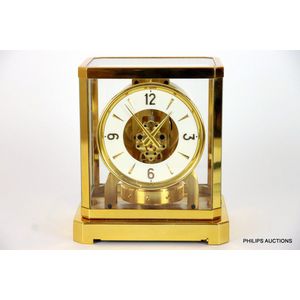Swiss Jaeger-Lecoultre Atmos Clock, 1940s-1950s
You must be a subscriber, and be logged in to view price and dealer details.
Subscribe Now to view actual auction price for this item
When you subscribe, you have the option of setting the currency in which to display prices to $Au, $US, $NZ or Stg.
- Pendulum - The pendulum was discovered around 1602 by Galileo Galilei, and was adopted for time keeping by the Dutch mathematician and natural philosopher, Christiaan Huygens, who excelled in astronomy, physics, and horology.
The pendulum comprises a metal rod usually of brass or steel with a metal disk, known as a bob, at the end. The movement of the pendulum is driven by weights or a spring, and as a pendulum swings in a regular arc, it was found accuracy could be controlled to within a few seconds a week.
Timekeeping can be adjusted by changing the height of the bob on the rod, making the pendulum either swing slower or faster.
The disadvantage of the pendulum was that changes in temperature also changed the length of the pendulum, interfering with the accuracy of the clock, and so in the 18th century two types of mercurial pendulums were invented which countered the movement in the steel rod.
The pendulum was the world's most accurate timekeeping technology until the invention of the quartz clock, regulated by a quartz crystal, in 1927. - Chapter Ring - A separate metal plate on the face of a clock, on which the numerals for the hours and sometimes parts of the hours, are displayed, usually wheel shaped and sitting on top of the dial plate. The chapter ring is often a feature of the clock and can be silvered or enamelled to stand as a contrast to its background. The hours are usually shown in Roman numerals, although in the late 19th and earlt 20th century, Arabic numerals became fashionable.
- Movement - The technical name for the workings of a clock or watch, and does not include the dial or case.
This item has been included into following indexes:
-
clocks, type
- Atmos 74
- four panel, four glass 33
Visually similar items

A fine Jaeger-LeCOULTRE 'Atmos' four glass brass clock, circa 1990s, Swiss made, marked 400096, a mechanical torsion pendulum clock with chapter ring and visible escapement deriving energy from atmospheric and temperature changes thereby removing requireme

Jaeger-LeCoultre Atmos clock, movement 237086, gilt finished case and movement, 15 jewel white chapter ring, brass hands, case, dial and movement signed. Height 22 cm

A Jaeger LeCoultre Atmos clock. Manufactured Switzerland, serial #461363, with glass panel, polished brass case, white chapter ring, and polished brass movement, with original makers box. Height 22 cm

A modern Atmos 'Classique' Goldtone Jaeger-LeCoultre perpetual clock, traditional gold plated brass case with glass panels to all sides and top, spirit level to base of case, adjustable feet, the chapter ring with Roman numerals, 15 jewels, open worked gol
